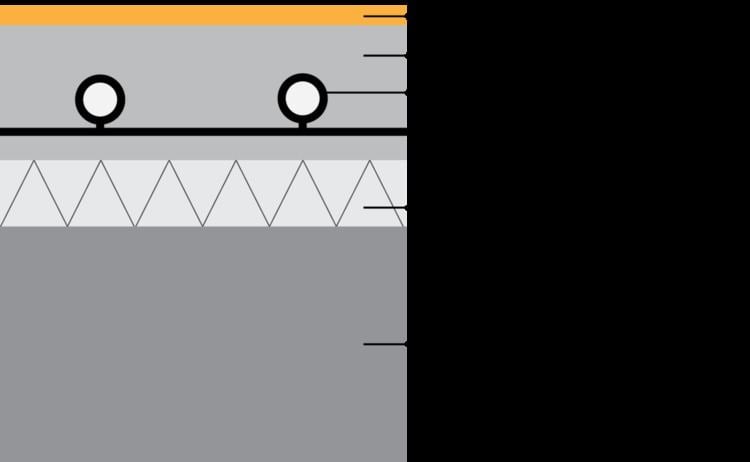 | ||
A radiant heating and cooling system refer to temperature-controlled surfaces that exchange heat with their surrounding environment through convection and radiation. By definition, in radiant heating and cooling systems, thermal radiation covers more than 50% of heat exchange within the space. Hydronic radiant heating and cooling system is water based radiant system. It refers to panels or embedded building components (floors, ceilings or walls). Other types include air-based and electrical systems (which use electrical resistance for heating purpose mainly). Important portions of building surfaces are usually required for the radiant exchange.
Contents
Applications
Radiant heating and cooling systems can be used in commercial, residential, education, and recreational buildings, museums, hospitals, and other type of buildings. The application depends on the type of radiant system (see below types of radiant systems), on climate conditions and on ventilation system used..
Radiative heat exchange
Heat radiation is the energy in the form of electromagnetic waves emitted by a solid, liquid, or gas as a result of its temperature. In buildings, the radiant heat flow between two internal surfaces (or a surface and a person) is influenced by the emissivity of the heat emitting surface and by the view factor between this surface and the receptive surface (object or person) in the room. The heat transfer by radiation is proportional to the power of four of the absolute surface temperature.
The emissivity of a material (usually written ε or e) is the relative ability of its surface to emit energy by radiation. A black body has an emissivity of 1 and a perfect reflector has an emissivity of 0.
In radiative heat transfer, a view factor quantifies the relative importance of the radiation that leaves an object (person or surface) and strikes another one, considering the other surrounding objects. In enclosures, radiation leaving a surface is conserved, therefore, the sum of all view factors associated with a given object is equal to 1. In the case of a room, the view factor of a radiant surface and a person depend on their relative positions. As a person is often changing position and as a room might be occupied by many persons at the same time, diagrams for omnidirectional person can be used.
Operative temperature and thermal comfort
The operative temperature is an indicator of thermal comfort which takes into account the effects of both convection and radiation. Operative temperature is defined as a uniform temperature of a radiantly black enclosure in which an occupant would exchange the same amount of heat by radiation plus convection as in the actual nonuniform environment.
With radiant systems, thermal comfort is achieved at warmer interior temp than all-air systems for cooling scenario, and at lower temperature than all-air systems for heating scenario. Thus, radiant systems can helps to achieve energy savings in building operation while maintaining the wished comfort level.
Radiant temperature asymmetry
The radiant temperature asymmetry is defined as the difference between the plane radiant temperature of the two opposite sides of a small plane element. As regards occupants within a building, thermal radiation field around the body may be non-uniform due to hot and cold surfaces and direct sunlight, bringing therefore local discomfort. The norm ISO 7730 and the ASHRAE 55 standard give the predicted percentage of dissatisfied occupants (PPD) as a function of the radiant temperature asymmetry and specify the acceptable limits. In general, people are more sensitive to asymmetric radiation caused by a warm ceiling than that caused by hot and cold vertical surfaces. The detailed calculation method of percentage dissatisfied due to a radiant temperature asymmetry is described in ISO 7730.
Design considerations
While specific design requirements will depend on the type of radiant system, a few issues are common to most radiant systems.
Hydronic radiant systems
Depending on the position of the pipes in the building construction, hydronic radiant systems can be sorted into 4 main categories:
Types (ISO 11855)
The norm ISO 11855-2 focuses on embedded water based surface heating and cooling systems and TABS. Depending on construction details, this norm distinguishes 7 different types of those systems (Types A to G)
Energy sources
Radiant systems are associated with low-exergy systems. Low-exergy refers to the possibility to utilize ‘low quality energy’ (i.e. dispersed energy that has little ability to do useful work). Both heating and cooling can in principle be obtained at temperature levels that are close to the ambient environment. The low temperature difference requires that the heat transmission takes place over relative big surfaces as for example applied in ceilings or underfloor heating systems. Radiant systems using low temperature heating and high temperature cooling are typical example of low-exergy systems. Energy sources such as geothermal (direct cooling / geothermal heat pump heating) and solar hot water are compatible with radiant systems. These sources can lead to important savings in terms of primary energy use for buildings.
Notable buildings using radiant systems
Map of buildings using hydronic radiant heating and cooling systems
